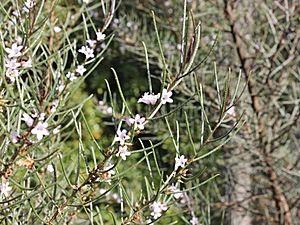Salt myoporum facts for kids
Quick facts for kids Salt myoporum |
|
|---|---|
 |
|
| Myoporum turbinatum in the ANBG | |
| Conservation status | |
| Scientific classification | |
| Genus: |
Myoporum
|
| Species: |
turbinatum
|
Salt myoporum (scientific name: Myoporum turbinatum) is a special plant. It belongs to the figwort family, called Scrophulariaceae. This plant only grows in a small area near Esperance in Western Australia. This means it is endemic to that spot.
It is a close relative of another plant called Myoporum platycarpum. However, salt myoporum has much thinner leaves. Its fruits also look different. You can easily spot this plant by its sticky branches and its thin, bumpy leaves.
Contents
What Does Salt Myoporum Look Like?
Salt myoporum is a shrub that stands upright. It can grow up to 4 metres (10 ft) tall. When the plant is young, it has many stems. As it gets older, it usually has only a few stems. These stems are bumpy and sticky. They only have leaves near their ends.
The leaves grow one after another along the stem. They are long and thin, usually 15–50 millimetres (0.6–2 in) long and 0.5–1.0 millimetre (0.02–0.04 in) wide. They are shiny, bumpy, and sticky. There is a small groove running along both sides of the leaves. Both sides are usually a dark green color.
Flowers and Fruits
The flowers grow where the leaves meet the stem. They usually appear in groups of 4 to 8. Each flower has a short stalk, about 1.5–4.5 millimetres (0.06–0.2 in) long.
Each flower has 5 egg-shaped sepals (these are like small leaves that protect the bud). It also has 5 petals that form a bell-shaped tube. The petals are white or sometimes a little pink. They might have spots inside the tube or at the base of their parts. The tube is 3–4 millimetres (0.1–0.2 in) long. The petal parts are shorter than the tube.
This plant produces flowers almost all year, except when there are droughts. After the flowers, dry fruits grow. These fruits are shaped like a spinning top. They are flat with a point at one end. They measure about 3–4.5 by 1.5–2.5 millimetres (0.1 in–0.2 in × 0.06 in–0.1 in).
Naming and Classification of Salt Myoporum
The scientific name Myoporum turbinatum was first officially described in 1986. A plant expert named Bob Chinnock gave it this name. He wrote about it in a science journal called Nuytsia. He studied a plant sample he found northeast of Esperance.
The second part of the name, turbinatum, comes from a Latin word. It means "shaped like a top." This refers to the unique shape of the plant's fruit.
Where Salt Myoporum Grows
Salt myoporum grows in a small area northeast of Esperance. This area is part of the Mallee region. It likes to grow in sandy soils near salty places. You can often find it growing with other plants like Melaleuca, Hakea, and Eucalyptus species.
Protecting Salt Myoporum
The Government of Western Australia Department of Parks and Wildlife has given Myoporum turbinatum a "Priority 4" classification. This means the plant is rare or almost threatened. It needs special attention to make sure it continues to survive in the wild. Protecting these unique plants helps keep our natural world healthy and diverse.


